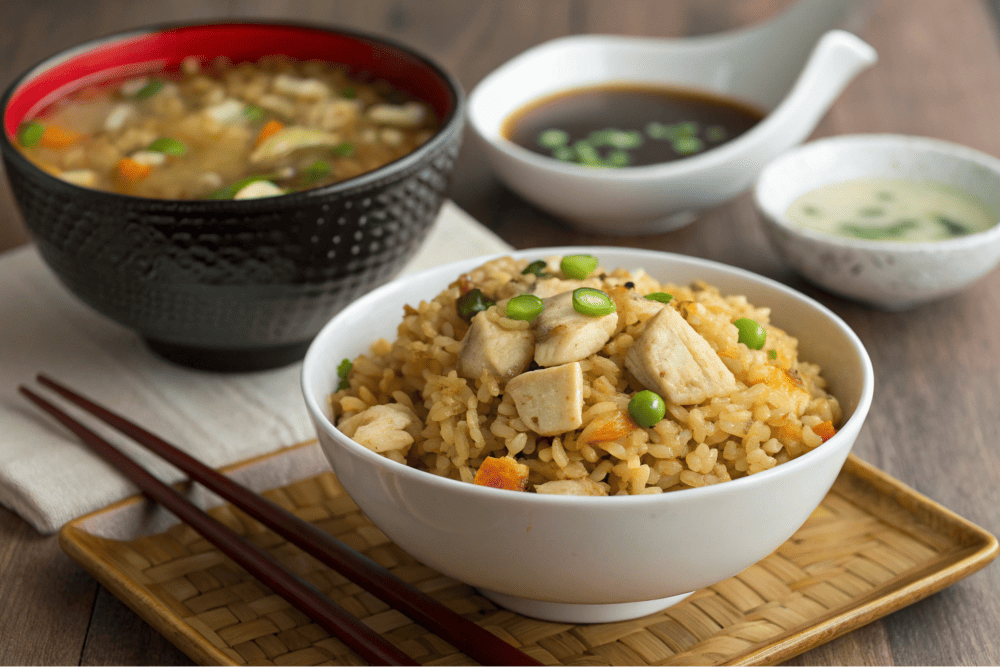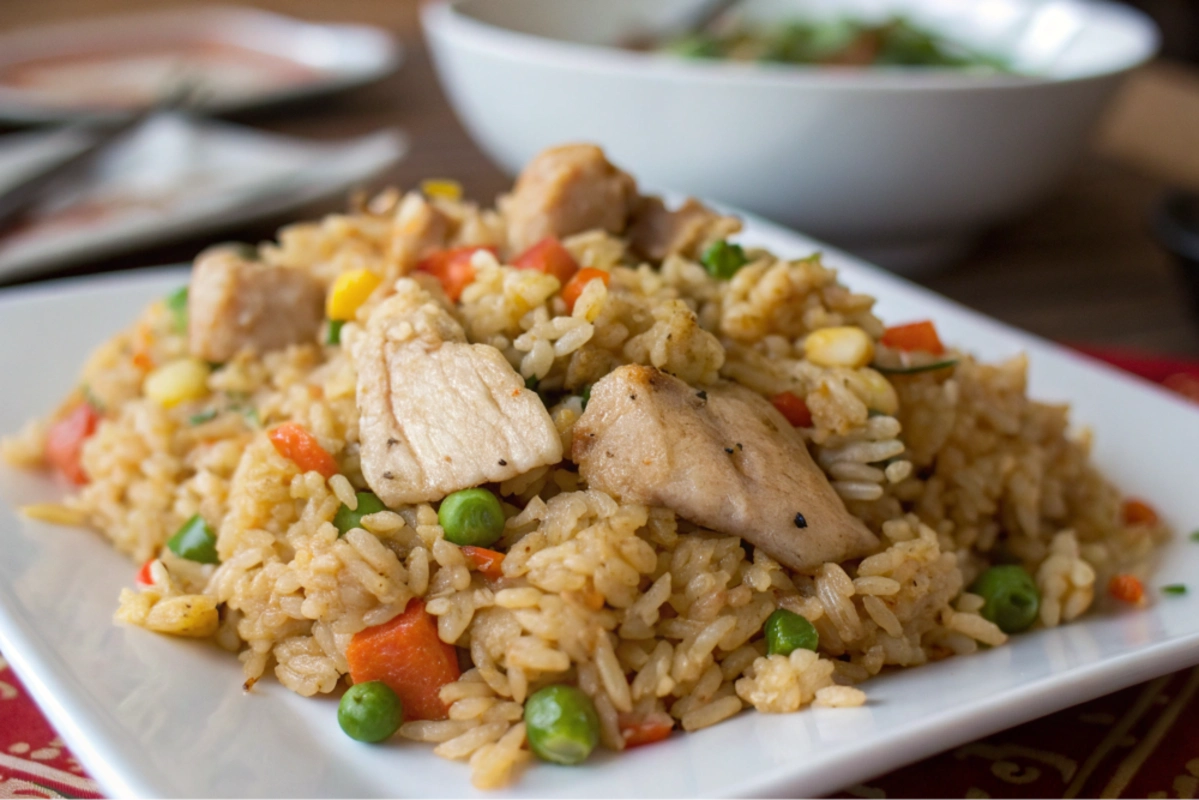If you’ve ever dined at Benihana or a similar hibachi-style restaurant, you know how irresistible their chicken fried rice is. With its perfect balance of savory, buttery, and umami flavors, this dish is a fan favorite. The best part? You don’t need a teppanyaki grill or a professional chef to recreate this magic at home. This Benihana Chicken Fried Rice Recipe brings the iconic flavors of the restaurant straight to your kitchen with simple ingredients and easy-to-follow steps.
Whether you’re looking for a quick weeknight meal or a way to impress your family and friends, this homemade version is sure to become a staple in your recipe collection. The combination of tender chicken, fluffy rice, and fresh vegetables, all tossed in a flavorful seasoning, makes this dish a crowd-pleaser. Plus, making it at home allows you to control the ingredients, ensuring a fresh, delicious, and healthier alternative to takeout.
What Is Benihana Chicken Fried Rice?
Benihana Chicken Fried Rice is a signature dish served at Benihana, a famous Japanese steakhouse chain known for its exciting hibachi-style cooking. The chefs prepare meals right in front of guests on a large, flat-top grill, creating an engaging and interactive dining experience. Among the many menu items, their fried rice stands out for its rich flavor, buttery texture, and the perfect blend of soy sauce, garlic butter, and scrambled eggs.
This dish starts with Japanese-style fried rice, which is different from traditional Chinese fried rice. It uses short-grain or medium-grain rice for a slightly chewy texture, and it’s cooked with a mix of ingredients like soy sauce, sesame oil, scrambled eggs, peas, carrots, and diced chicken. A key ingredient that sets it apart is the garlic butter, which adds a deep, savory richness to every bite.
Why You’ll Love This Recipe
There are many reasons why this Benihana Chicken Fried Rice Recipe is worth trying at home. Here’s why you’ll love it:
- Authentic Restaurant-Style Flavor: This recipe mimics the original Benihana fried rice, so you can enjoy the same delicious taste without leaving your house.
- Easy and Quick to Make: With just a few simple steps, you can whip up this meal in under 30 minutes, making it perfect for busy weeknights.
- Customizable to Your Taste: Want to add more veggies or swap out the protein? You can easily adjust the ingredients to fit your preferences.
- Healthier Than Takeout: By cooking at home, you can control the amount of oil, butter, and sodium, making this a healthier alternative to restaurant fried rice.
- A Great Way to Use Leftover Rice: Day-old rice works best for fried rice, so this dish is an excellent way to repurpose leftovers into something flavorful and satisfying.
Bringing the Hibachi Experience to Your Home
One of the best parts of eating at a hibachi restaurant like Benihana is the experience itself. The sizzling grill, the chef’s impressive knife skills, and the delightful aroma of freshly cooked ingredients make dining there unforgettable. While you may not have a hibachi grill at home, you can still recreate the flavors and experience by cooking this Benihana Chicken Fried Rice Recipe in a large skillet or wok.
To take it a step further, consider serving it alongside other hibachi-style dishes like grilled shrimp, steak, or sautéed vegetables. Pair it with a simple homemade yum yum sauce or a light miso soup for the full Japanese steakhouse experience.
By following this recipe, you’ll bring the magic of Benihana into your own kitchen, creating a meal that is both comforting and delicious. Stay tuned for the full step-by-step guide to making this flavorful dish at home!
Essential Ingredients for Fried Rice

To make an authentic Benihana Chicken Fried Rice Recipe, it’s crucial to start with the right ingredients. Here’s everything you’ll need:
- Day-old cooked rice – The key to achieving that perfect fried rice texture.
- Chicken – Diced into bite-sized pieces, typically boneless skinless chicken breast.
- Eggs – Scrambled into the rice to add smoothness and richness.
- Vegetables – A mix of peas, carrots, and onions for flavor and color.
- Soy sauce – For that umami flavor that defines fried rice.
- Sesame oil: The deep, nutty flavor of toasted sesame oil is what makes dishes like fried rice truly stand out. It’s a crucial ingredient, so make sure you don’t skip it!
- Butter and garlic – These ingredients are essential for flavor depth.
- Optional garnishes – Top with sesame seeds or green onions for extra flavor.
How to Prepare Your Fried Rice
Creating the perfect Benihana Chicken Fried Rice Recipe requires a few simple steps. However, a little technique goes a long way. Follow these steps, and you’ll achieve restaurant-quality fried rice:
- Prepare the rice: First, make sure you use day-old rice. Fresh rice is too soft and can result in mushy fried rice. Spread the rice out and allow it to cool before using it.
- Cook the chicken: In a hot pan, cook the chicken until golden brown and cooked through. This step locks in the flavors.
- Scramble the eggs: In the same pan, scramble the eggs and set them aside once they’re fully cooked.
- Sauté the vegetables: In a separate pan, sauté peas, carrots, and onions until they’re tender yet crisp.
- Combine everything: Add the rice to the pan with the vegetables, then add the cooked chicken and scrambled eggs.
- Season it: Finally, drizzle in soy sauce and Sesame oil and stir in butter and garlic to give the fried rice that classic hibachi flavor.
With these steps, your rice will be perfectly seasoned and fried, providing the right balance of textures and flavors. This method guarantees you’ll have a delicious Benihana Chicken Fried Rice Recipe every time.
Pro Tips for Perfect Fried Rice
Achieving the perfect Benihana Chicken Fried Rice Recipe requires more than just the right ingredients; technique is key. Here are a few tips to make sure it turns out just right:
- Use day-old rice: Fresh rice will clump together, whereas day-old rice will fry up perfectly, giving you that crispy texture.
- High heat is essential: Stir-frying over high heat ensures that the rice gets crispy and golden without overcooking the ingredients.
- Don’t overcrowd the pan: If you add too much rice at once, it will steam instead of fry, resulting in soggy rice.
- Use garlic butter: Adding garlic butter enhances the flavor, giving the fried rice a rich and savory finish.
In addition, for an even deeper dive into stir-frying techniques, explore more about how to perfect fried rice at home.
Variations of Benihana Chicken Fried Rice
While the traditional Benihana Chicken Fried Rice Recipe is a classic, feel free to experiment with different variations. Here are some ideas you can try:
- Shrimp Fried Rice: Swap the chicken for shrimp for a seafood twist. You can get inspiration for seafood dishes from the Crab Brulee Recipe.
- Vegetarian Fried Rice: Leave out the chicken and load up on veggies or tofu for a vegetarian version.
- Spicy Fried Rice: Add chili peppers or a dash of hot sauce for those who like a spicy kick.
- Eggless Fried Rice: For a vegan option, skip the eggs and use tofu or a vegan egg alternative.
By experimenting with different ingredients, you can customize the dish to suit your preferences.
Serving Suggestions and Pairings
This Benihana Chicken Fried Rice Recipe can be served as a standalone dish, but it also pairs wonderfully with a variety of sides. For example, consider serving it with:

- Hibachi-style vegetables: Grilled zucchini, mushrooms, and bell peppers make a fantastic side dish.
- Miso soup: A light, flavorful miso soup complements the richness of the fried rice.
- Sake or light beer: For an authentic hibachi experience, pair your fried rice with chilled sake or a light beer.
These sides enhance the fried rice and elevate the overall meal.
Common Mistakes to Avoid
To make sure your fried rice turns out perfectly, avoid these common mistakes:
- Using fresh rice: Freshly cooked rice is too soft. Always use day-old rice for the best texture.
- Overcooking the vegetables: Vegetables should be tender but still have a slight crunch.
- Not using enough oil or butter: These ingredients help achieve that signature crispy fried rice texture.
By following these tips, you can avoid common pitfalls and make the best fried rice possible.
How to Make Fried Rice Gluten-Free Recipe: A Safe and Savory Delight
Fried rice is a delicious and versatile dish that can easily be adapted to meet dietary needs. For those who need to avoid gluten, a few simple ingredient swaps can transform this classic favorite into a safe, gluten-free meal without sacrificing flavor or texture. Here’s how to do it:
Key Adjustments for Gluten-Free Fried Rice
- Soy Sauce Replacement
Traditional soy sauce contains wheat, making it unsuitable for a gluten-free diet. Substitute it with tamari or gluten-free soy sauce to retain the savory umami flavor that defines fried rice. - Choose Gluten-Free Sesame Oil
Sesame oil adds a nutty depth to fried rice, but it’s essential to check that the product is certified gluten-free to avoid cross-contamination. - Use Pure Butter and Fresh Garlic
Stick to unsalted, pure butter and freshly minced garlic. Avoid garlic powders or pre-made seasonings that might have been processed in facilities handling gluten. - Select Safe Vegetables
Opt for fresh or frozen vegetables, ensuring they are not pre-seasoned or coated in sauces containing gluten. Favorites like peas, carrots, and onions work perfectly, but feel free to add bell peppers, broccoli, or corn for variety.
Pro Tips for Success
- Always double-check labels on packaged ingredients to ensure they are certified gluten-free.
- Use day-old cooked rice for the best fried rice texture. Fresh rice tends to be too moist and sticky.
- Tamari often has a richer taste than gluten-free soy sauce and is naturally gluten-free, making it a great alternative.
With these easy substitutions, you can enjoy a gluten-free version of fried rice that’s every bit as delicious as the original. Perfect for a quick meal or a family favorite, this recipe keeps all the flavor while meeting dietary needs. For other savory fried recipes, you can check out the Hillbilly Fish Fry Seasonings Recipe or explore the Longhorn Parmesan Crusted Chicken Recipe.
Frequently Asked Questions
How to Fix Undercooked Fried Rice ?
If your fried rice is undercooked, don’t worry! Here’s how to fix it:
- Add Liquid: Sprinkle a small amount of water or broth over the rice.
- Cover and Steam: Cover the pan with a lid to trap the steam. Cook on low heat for a few minutes to soften the rice.
- Stir Gently: Stir occasionally to ensure even cooking without making the rice mushy.
- Check Texture: Taste and repeat if needed until the rice is fully cooked.
Avoid adding too much liquid at once to maintain the fried rice texture.
Does Soy Sauce Go Bad If Not Refrigerated?
No, it doesn’t spoil quickly due to its high salt content, which acts as a natural preservative.
- Unopened Soy Sauce: It can last for years when stored in a cool, dark place.
- Opened Soy Sauce: It remains safe at room temperature, but its quality—flavor, aroma, and freshness—may decline over time.
While refrigeration isn’t required, it’s recommended for opened soy sauce to maintain its best taste for months. So, while soy sauce won’t easily go bad, refrigerating it ensures a longer shelf life and premium flavor.
What Is the Secret Ingredient to Restaurant Fried Rice?
The secret to restaurant-style fried rice lies in a few key ingredients and techniques, but one standout secret ingredient is day-old rice. Here’s why:
- Day-Old Rice: Slightly dried-out rice is less sticky and absorbs flavors better, giving fried rice its distinct texture.
- Soy Sauce: Adds umami and depth without overwhelming the dish.
- Oyster Sauce or Fish Sauce: These enhance the savory flavor, making it richer and more complex.
- Sesame Oil: A drizzle at the end boosts aroma and authentic taste.
Combine these with high heat and constant stirring for that perfect restaurant-style fried rice!
Is Undercooked Rice Bad for You?
Yes, undercooked rice can be harmful to your health. Here’s why:
- Digestive Issues: Undercooked rice is harder to digest and can cause stomach discomfort, bloating, or gas.
- Bacteria Risk: Raw or undercooked rice may contain Bacillus cereus, a bacterium that can survive cooking. Consuming it can lead to food poisoning, causing nausea, vomiting, or diarrhea.
- Nutrient Absorption: Improperly cooked rice may not allow your body to absorb its nutrients effectively.
Solution: Always cook rice thoroughly, ensuring it’s soft and no longer crunchy. Proper cooking eliminates bacteria and makes rice safe and easy to digest. If in doubt, add a little water and let it steam until fully cooked.
How do I store leftover fried rice?
Store leftover rice in an airtight container in the refrigerator for up to 3 days. Reheat in a pan with a little oil to restore the crispy texture.
Can I use frozen rice?
Frozen rice can be used, but make sure to thaw and cool it before using it to avoid a soggy texture.

